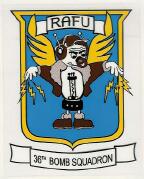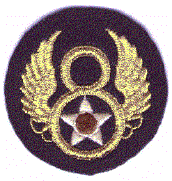
THE 36th BOMB SQUADRON
RCM
The 8th Air Force's only Radar CounterMeasures (RCM) Squadron.
Dedicated to the men and women both air and ground who were the "Gremlins".
HISTORY

HISTORY OF THE SECRET RADAR COUNTERMEASURE SQUADRON
The 8th Air Force's 36th Bomb Squadron (RCM), a secret radar countermeasure unit was not involved in typical bombing runs as other bomb squadrons. It only compared to other bomb squadrons due to the fact that heavy B17 and B24 bombers were used. The 36th Bomb Squadron was born out of the 803rd Bomb Squadron (Provisional). This special unit worked initially with the RAF 100 Bomb Group at Sculthorpe in January of 1944 and was first commanded by Capt. George E. Paris. This first detachment had already completed an operational tour. The radar countermeasure effort came under RAF Bomber Command where they performed a variety of special operational activities. The secret missions included Window (Chaff), Jostle, Carpet, Mandrel, and other ramifications. Many of the aircraft jamming systems were developed and tested by Allied scientists associated with the Telecommunications Research Establishment, namely the American-British Laboratory Division 15 (ABL-15) located at Great Malvern, near London. RCM operations were designed to deny the Germans effective utilization of radar and radio equipment, which generally fell into these main categories:
1. Small Wurzburg - used in fire control of flak batteries against Allied aircraft.
2. Giant Wurzburg - employed in control of enemy fighters and anti-aircraft fire.
3. Freya - used with Giant Wurzburg for fighter control and long distance warning radar.
4. Big Ben Jostle - used to jam potential V2 rocket radio control.
Lt. Col. Clayton A. Scott assumed command of the 803rd on April 25,1944. At this time the new squadron included nine crews and six B17 aircraft. On May 16, 1944 the squadron moved to RAF Oulton. The first operational mission using four B17 aircraft was on the night of June 5/6 with RAF 100 Group squadrons. Its purpose was to mask the Allied invasion fleet and to support the airborne operations on the Normandy beachhead. This Mandrel mission proved very effective in countering the German early warning system and "contributed materially to the success of the landings on the beachhead". Initially the screens were flown at 15,000 feet, but were later increased to 19,000 feet. Soon it was found that the B24 Liberator was better suited in delivering a more ample power supply to the high voltage jammers than the B17 Flying Fortress and by the end of July the squadron initiated a changeover to an all Liberator fleet.
In August the personnel from the 803rd merged with those from Det. "A" of the 858th Bomb Squadron and the 856th Bomb Squadron to form the new 36th Bomb Squadron (H) RCM. At this time Major Robert F. Hambaugh assumed command. He continued in that capacity until after the war's end. RCM night missions continued in support of Bomber Command which targets included Berlin, Kiel, Dortmund, Stettin, and Hamburg plus other targets. Frequency search missions were also flown at the request of the American British Laboratories. Mission successes continued as shown by the Mandrel screen and the Special Window operation for the raid on Bremershaven in September. Long-range raid information was denied and enemy plotting system confused. The intended results were found when the enemy night fighter interception was late against the main RAF attacking force. Successful "spoof" jamming missions were also commenced when RAF Bomber Command had no operations. Deceived by the "spoof" and believing a RAF bombing raid was approaching, enemy controllers at the radar stations would initiate fighter action. In October reduced bomber losses over the continent were being attributed to enemy fighters by the screening efforts.
On Nov. 25, 1944, operations with the RAF were curtailed. Support was now being given to the 8th Air Force for VHF screens. The VHF screen for the Air Division assemblies was designed to deny the enemy valuable information in regards to the attacking force size, route, altitude, and target. December and January brought continued VHF jamming screens and new Jackal or Nazi tank communication jamming commenced for the Battle of the Bulge. Special operations of prepared dialogue to simulate bomber division assembly were employed on days when there were no bombing operations by Bomber Command. The intent of this effort was to further extend the enemy resources. On frequent occasions, due to diversions, squadron operations were conducted from other bases. On January 3, 1945 operations with the RAF ended. During March and April of 1945, "droop snoot" P38's assisted the 36BS B24's and actively investigated radar frequencies not covered by Carpet and Window jamming. All support operations ceased by April 30, 1945.
There were 1167 effective
sorties out of a total of 1218 flown on 220 missions during the short eleven months of
this very special squadron. Twenty-seven airmen lost their lives in service with the RCM
squadron.